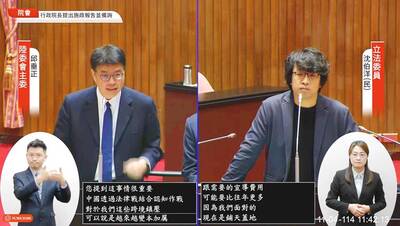Letters mailed to Lienchiang County, which includes the island of Matsu, often go astray. The reason: China also has a Lienchiang County, which is just a few kilometers from Taiwan's.
The "small three links," initiated in January 2001, allow trade, mail and people to cross the small stretch of water between Taiwan's Kinmen and Lienchiang counties and China's Fujian Province.
The new links between the two government agencies with the name Lienchiang County sometimes leave the mailmen baffled.
To end to the confusion, the Lienchiang County Government under Taiwan's control recently proposed surveying its residents on whether the county's name should be changed to Matsu, a name more familiar to the public.
"Ever since we started implementing the `small three links,' cases of mail being misdelivered -- because of confusion between my county and that of China's -- are frequent," said Lienchiang County Commissioner Chen Hsueh-sheng (
The confusion is a legacy of the Chinese civil war. In 1949, the retreating KMT forces took control of the province of Taiwan and also of Kinmen and Matsu, which are part of Fujian Province.
All of Kinmen County came under the KMT's control, but only part of Lienchiang County.
The opening of direct mail links between the two sides has now brought the situation to a head, Chen said.
"I personally have no specific preference as to whether the county's name should stay as Lienchiang or be changed to Matsu," said Chen, who is a member of the PFP. "The proposal is suggested purely to put an end to all the arguments over the county's name."
Aside from problems of missing mail, Chen said that many locals advocated the name change because Matsu is a more commonly used name.
Most of people in Taiwan know the 19 islets that make up Taiwan-controlled Lienchiang County as Matsu rather than by its official name.
"People who wish to have the county's name changed to Matsu said that Matsu was a name that's more well-known and recognizable to outsiders and has a higher profile in the international community," Chen said.
Chen, however, also noted that there were some locals who opposed the name change because it smacked of the independence stance held by the DPP government.
"Some people are concerned that to change the county's name would seem to support former president Lee Teng-hui's (
Chen was referring to comments by Lee that called on Taiwanese to forge a new Constitution and change the nation's name from the Republic of China to Taiwan.
"Some, who want to uphold the historical name of Lienchiang, regard any change to the county's name as a precursor to Taiwan's independence," Chen said.
The commissioner also said that because the county has only 9,000 residents, some feared that pushing for the name change would give central government politicians an excuse to abrogate Lienchiang's status as a county.
"Given all these various opinions on whether the county should change its name, we hope a majority stance can be ascertained through a survey, thereby ending the arguments," Chen said.
The county government has hired a polling company to carry out the survey, he said.
"The firm has just finished a series of explanatory meetings around the islands on this matter," Chen said. "The survey is likely to be held no later than June."
He said the survey would then be distributed to all households.
"If 70 to 80 percent of the people agree to have the county's name changed, then the county government will go ahead and submit the proposal to the county council," Chen said.
"If the county council passes the proposal, then it will take the issue to the Ministry of the Interior to begin the procedure to change the name," he said.
While this procedure is mandated in the Law on Local Government Systems (地方制度法), Lienchiang's move would set a precedent.
"So far, no local government has made such a request," said Lin Mei-chu (

CALL FOR SUPPORT: President William Lai called on lawmakers across party lines to ensure the livelihood of Taiwanese and that national security is protected President William Lai (賴清德) yesterday called for bipartisan support for Taiwan’s investment in self-defense capabilities at the christening and launch of two coast guard vessels at CSBC Corp, Taiwan’s (台灣國際造船) shipyard in Kaohsiung. The Taipei (台北) is the fourth and final ship of the Chiayi-class offshore patrol vessels, and the Siraya (西拉雅) is the Coast Guard Administration’s (CGA) first-ever ocean patrol vessel, the government said. The Taipei is the fourth and final ship of the Chiayi-class offshore patrol vessels with a displacement of about 4,000 tonnes, Lai said. This ship class was ordered as a result of former president Tsai Ing-wen’s (蔡英文) 2018

‘SECRETS’: While saying China would not attack during his presidency, Donald Trump declined to say how Washington would respond if Beijing were to take military action US President Donald Trump said that China would not take military action against Taiwan while he is president, as the Chinese leaders “know the consequences.” Trump made the statement during an interview on CBS’ 60 Minutes program that aired on Sunday, a few days after his meeting with Chinese President Xi Jinping (習近平) in South Korea. “He [Xi] has openly said, and his people have openly said at meetings, ‘we would never do anything while President Trump is president,’ because they know the consequences,” Trump said in the interview. However, he repeatedly declined to say exactly how Washington would respond in

WARFARE: All sectors of society should recognize, unite, and collectively resist and condemn Beijing’s cross-border suppression, MAC Minister Chiu Chui-cheng said The number of Taiwanese detained because of legal affairs by Chinese authorities has tripled this year, as Beijing intensified its intimidation and division of Taiwanese by combining lawfare and cognitive warfare, the Mainland Affairs Council (MAC) said yesterday. MAC Minister Chiu Chui-cheng (邱垂正) made the statement in response to questions by Democratic Progressive Party (DPP) Legislator Puma Shen (沈柏洋) about the government’s response to counter Chinese public opinion warfare, lawfare and psychological warfare. Shen said he is also being investigated by China for promoting “Taiwanese independence.” He was referring to a report published on Tuesday last week by China’s state-run Xinhua news agency,

‘ADDITIONAL CONDITION’: Taiwan will work with like-minded countries to protect its right to participate in next year’s meeting, the foreign ministry said The US will “continue to press China for security arrangements and protocols that safeguard all participants when attending APEC meetings in China,” a US Department of State spokesperson said yesterday, after Beijing suggested that members must adhere to its “one China principle” to participate. “The United States insists on the full and equal participation of all APEC member economies — including Taiwan — consistent with APEC’s guidelines, rules and established practice, as affirmed by China in its offer to host in 2026,” the unnamed spokesperson said in response to media queries about China putting a “one China” principle condition on Taiwan’s